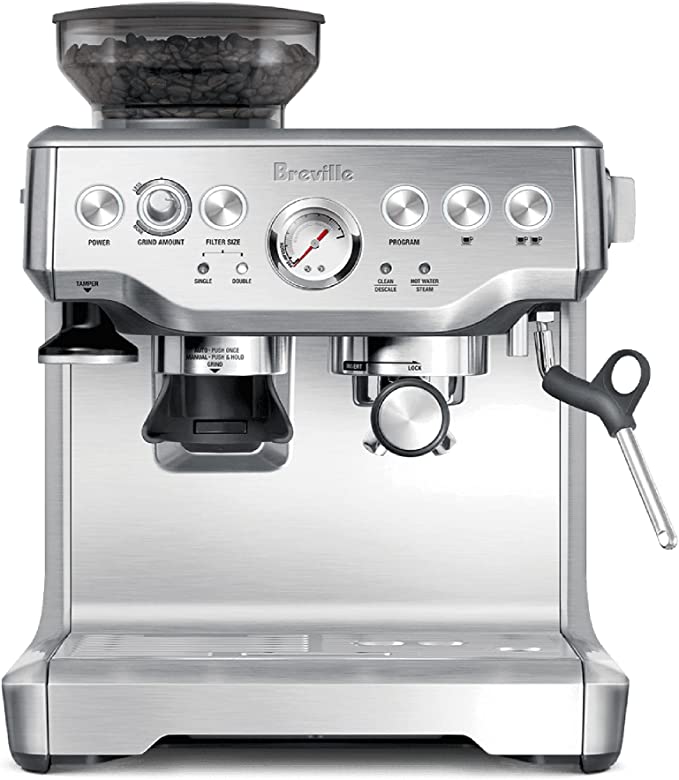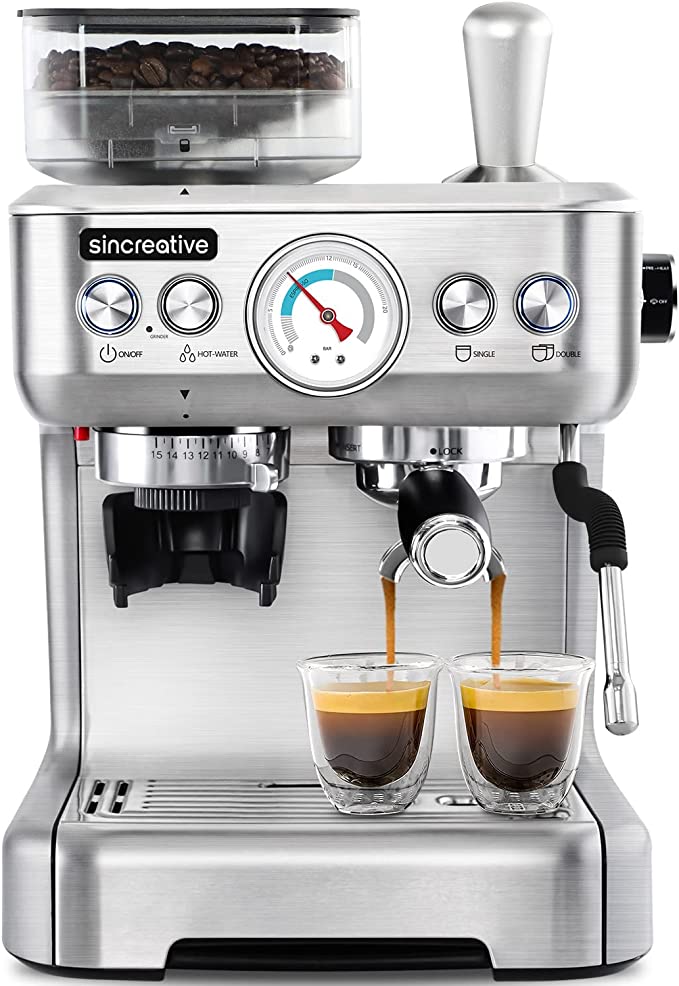Unlock the Perfect Espresso: Your Guide to Coffee Science with the Nespresso Pixie
Update on June 9, 2025, 12:17 p.m.
There’s a ghost in the machine. It’s there in the quiet hum that precedes the pour, in the hiss of steam, and most vividly, in the cascading stream of umber liquid that settles into a perfect, hazel-hued crown of foam. This is the crema, the beautiful, aromatic soul of espresso. For a fleeting moment, as you watch it form, you are connected to a long chain of innovation, a relentless, century-long quest to capture lightning in a cup. And then you realize this minor miracle isn’t happening in a bustling Milanese café, but on your own kitchen counter, produced by a machine barely wider than a coffee mug.
How did we get here? How did the arcane art of the barista—a delicate dance of grinding, tamping, timing, and intuition—get distilled into the heart of a compact appliance like the Nespresso BEC430TTN Pixie? The answer isn’t just about convenience; it’s a fascinating story of physics, chemistry, and engineering ingenuity, a tale of how we learned to tame giants and shrink them to fit our modern lives.

The Birth of Liquid Gold
To understand the Pixie, we must first travel back to post-war Italy. Before 1948, “espresso” was a harsh, often bitter affair, brewed with scalding steam that scalded the coffee grounds. Then, a Milanese café owner named Achille Gaggia had a revolutionary idea. Instead of steam, he used a hand-operated piston to force hot water through the coffee at a high, controlled pressure. The result was transformative. For the first time, the world saw a thick, stable, reddish-brown crema. Gaggia hadn’t just made better coffee; he had unlocked its soul. He proved that the perfect espresso required two fundamental pillars: immense pressure and precise temperature. This discovery set the gold standard, but it also created a challenge that would define coffee technology for the next 70 years: how to replicate that perfect, high-pressure extraction consistently, easily, and outside the confines of a specialized café.

Taming the Giant: The Physics of Pressure
At the core of Gaggia’s discovery was pressure. The Specialty Coffee Association (SCA), the world’s leading authority on coffee standards, confirms that the ideal pressure for extracting espresso is around 9 bars. But what is a bar? It’s a unit of pressure roughly equal to the atmospheric pressure at sea level. So, 9 bars is nine times the air pressure all around you—comparable to the pressure experienced by a diver 90 meters (nearly 300 feet) underwater.
Why this immense force? Think of the finely ground coffee in a capsule as a tightly packed, stubborn dam. The 9-bar pressure is the force needed to push water evenly through this resistance. More importantly, this hydraulic force performs a chemical magic trick: emulsification. It violently agitates and disperses the microscopic oils within the coffee grounds, suspending them in the water. These emulsified oils are what form the rich, velvety texture and the stable, long-lasting crema. Without this pressure, you simply have strong, filtered coffee.
This brings us to the Pixie’s heart: its 19-bar pump. At first glance, this seems like overkill. If the goal is 9 bars, why provide more than double the power? This is a deliberate and brilliant piece of engineering. The 19-bar rating is the pump’s maximum potential output, a reserve of power that ensures it can always deliver a consistent 9 bars at the capsule, no matter the slight variations in coffee grind or density. It’s like having a car with a top speed of 150 mph to ensure it can effortlessly and smoothly cruise at 70 mph, even uphill. This engineering overhead is the secret to the Pixie’s remarkable consistency, shot after shot. It’s a miniature hydraulic press, designed to conquer resistance and guarantee a perfect, crema-rich extraction every time.
Dancing on a Razor’s Edge: The Thermodynamics of Taste
If pressure is the power, temperature is the precision. The extraction of flavor from coffee is a delicate chemical reaction, hyper-sensitive to heat. The SCA defines the ideal temperature window as a razor-thin 195°F to 205°F (90°C to 96°C). Veer too high, and you scorch the grounds, releasing harsh, bitter compounds. Go too low, and you fail to dissolve the desirable sugars and acids, resulting in a thin, sour, and unsatisfying cup.
Traditional espresso machines tackled this with heavy, brass boilers that would heat a large reservoir of water—a slow, energy-intensive process. The Pixie, however, employs a far more nimble technology: the Thermoblock. Instead of a boiler, imagine a winding, narrow metal labyrinth. As the pump pushes a precise amount of cold water into this labyrinth, a powerful heating element wrapped around it instantly brings the water up to the perfect extraction temperature just as it’s needed.
This is the science behind the Pixie’s astounding 25-second heat-up time. It’s a masterpiece of thermodynamics and efficiency. By heating water on-demand, it not only provides incredible speed but also surgical temperature stability, hitting that narrow flavor window with precision. This system, drawing its full 1260 watts only when needed, is also why the machine can be so energy-conscious, automatically powering down after a few minutes of inactivity. It’s the difference between warming up a massive cast-iron oven and lighting a sleek, instantaneous gas cooktop.

The Time Capsule: Chemistry in Aluminum
The final piece of the puzzle was solving the problem of freshness. Ground coffee is chemically volatile. The moment it’s exposed to air, a process of oxidation begins, degrading the delicate aromatic oils and turning them stale. A perfect grind, pressure, and temperature are all for naught if the coffee itself is not fresh.
This challenge was famously solved in the 1970s by a Nestlé engineer, Éric Favre, leading to the invention of the Nespresso capsule. The capsule is more than just a container; it’s a hermetically sealed fortress. Aluminum was chosen for its unique properties: it is infinitely recyclable, lightweight, and, most importantly, it forms a perfect, inert barrier to oxygen, light, and moisture. Each capsule is a time capsule, preserving the coffee’s peak flavor from the roaster until the moment it’s pierced in the machine. When the Pixie’s automated mechanism pierces the foil and injects high-pressure, perfectly heated water, it is unleashing chemistry that has been held in suspended animation.

Epilogue: The Democratization of the Daily Ritual
In its sleek, 4.3-inch-wide frame, the Nespresso Pixie is a vessel of history and science. It houses the ghost of Achille Gaggia’s revolutionary idea, the precision of modern thermodynamics, and the protective chemistry of a sealed aluminum pod. Every feature, from the folding drip tray that accommodates a larger mug to the 24-ounce water tank that minimizes refills, is a thoughtful solution to the constraints of a real-world kitchen.

By automating the variables that once demanded years of practice, the Pixie achieves something remarkable: the democratization of high-quality espresso. It takes a complex scientific process and makes it simple, repeatable, and accessible. It cannot replicate the romance of a vintage Faema E61 or the hands-on craft of a master barista, nor does it try to. Instead, it delivers on a different, more modern promise: that the pleasure of a truly great cup of coffee, the result of a century of relentless innovation, should not be an exclusive luxury, but a simple, daily ritual. It is a pocket rocket, a small miracle of engineering that proves the most profound experiences often come in the most compact packages.







































